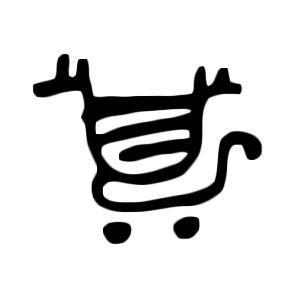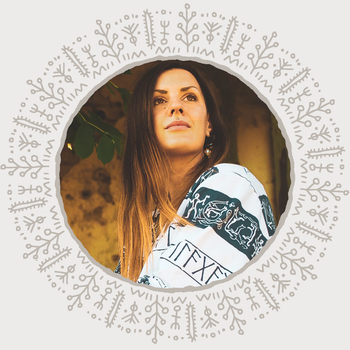Viking Games
← BackLet us start with the board games, which there are many archeological physical finds in different locations throughout northern Europe.
It may refer to the very common throwing game called “kubb” that is usually practiced during the Swedish midsummer, where you throw pins in the hopes of finally overthrowing the opponent’s armies and eventually the king in order to win.
Or it may refer to what is known as an old Nordic board game with many different names around Europe. It can be called “Hnefatafl”, “Tablut”, “Tafl”, “King’s table”, “Bräde”, “Königszabel'' or “Kongens bord”, but for simplicity we will in this post refer to it as “Hnefatafl”. This board game does indeed remind of an older variation of chess.
Hnefatafl is mentioned in the Icelandic sagas, and it seems like a skilled player would withhold a good status amongst their peers. Hnefatafl was played just like chess; on a checkered board, but with an odd number of squares, for example 5x5, 9x9 or 11x11. The middle-square of the board would be distinct and stand out.
The pieces of Hnefatafl were meant to resemble two different armies, where one of them has a chief, king or jarl (whichever you prefer to call it) together with protectors. The other army would have similar pieces and they would play the aggressor. The aggressor’s pieces would be twice as many as the protectors. The word “hnefi” stands for the king of this game. Why the middle-square is standing out on the board is because that is the location of the king-piece, surrounded by his small army of protectors. The whole point of the game is that the king should be able to escape in order for the player who plays the protective side of the game to win, and if the king doesn’t make it out of harm's way, the player on the aggressors’ side would win.
The rules of this game have been reconstructed based upon finds of game pieces from around the Viking age and the observation of a Sami game (called Tablut) being played in 1732. Tablut seemed to have been a very similar (if not the exact same) game as the Hnefatafl. While the actual way of how it was played is unknown and it couldve varied from place to place we still have the reconstructed version so let's go over how a table of hnefatafl wouldve been set up and played!











Alternatively white wins when the king reaches a square black stood on

Alternatively black wins when the king is surrounded on 3 sides and the edge
Just make sure your board has an odd number of squares (starting from 9x9 up to 19x19 squares), place the king in the middle and the attacking team on the corners of the board like I've depicted on the picture below (tap on them to open a larger view):
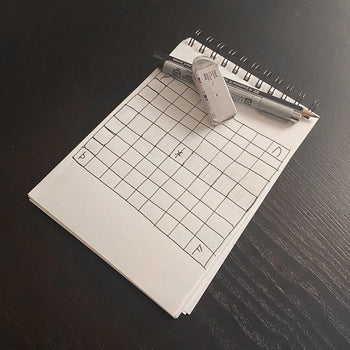
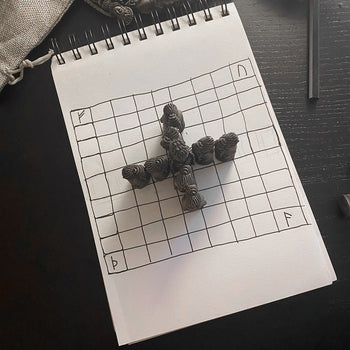
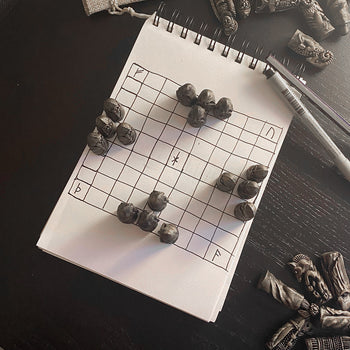
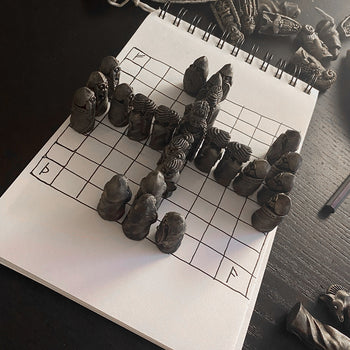
There are several historical finds of gaming pieces that are thought to belong to the game of Hnefatafl; how the tafl aspect shows in an archaeological context is that there is one gaming piece that stands out, presumably the king-piece. There has also been finds of several dices together with the gaming pieces. How the dices has been used for that particular game we do not exactly know. It is of course highly possible that the people of the Viking age had many different forms of games using dices and pieces.
Some of the pieces that has been found in Birka (Sweden) are made from beautiful blue glass or with bronze details, while others are more common looking and made out of bone. There has been finds of a game piece on the island of Lindisfarne, which is believed to date back to the first raidings by the vikings during the year 793 A.D. The Lindisfarne game piece has swirls and a blue tint similar to a glass set found in Birka (Sweden).
Game pieces are commonly found in graves from the Scandinavian Vendel- and Viking age, there are several exciting examples such as the “Viking Warrior Woman” of Birka (Sweden), the “Salme Ship Burials” in Salme (Estonia) and “Boatgrave 9 of Vendel” (Sweden). The Salme ship burial site was filled with over hundreds of gaming pieces, which is totally understandable, since just as in the case of the Lindisfarne piece – going on a boat journey for a long while might get a bit too boring after a couple of days. Board games are therefore a perfect activity to make the time pass by faster.
Many of the sets that has been found in graves have had the characteristics of the Hnefatafl with the one bigger gaming piece standing out – the king piece. Since these games have been discovered as grave goods, it isn’t impossible that they had a high status and were considered personal enough to whomever owned them, to also bring them along to the afterlife.
It is also worth mentioning that there are runestones that depict board games. In Gästrikland (Sweden) there is a image carved in stone that seems to portray what looks like two men drinking out of drinking horns and playing a board game, maybe Hnefatafl (Ockelbostenen GS-19, Sweden).

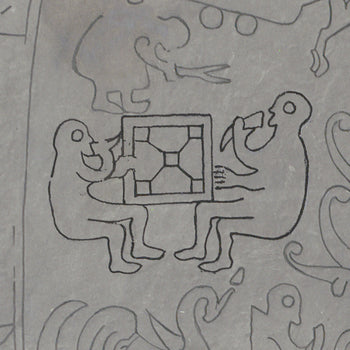

Everyone sits upon their noble teammate, puts themselves in a strategic line and does not move until a chosen person blows their battle horn or whistles through their lips, whatever suits you best. After the signal you better get ready for Ragnarök itself! The game consists of the riders trying to make their opponents fall off their “horses”. The teammate who plays the horse makes sure that the rider is safe and does not fall down by holding on to their legs. Only the riders are allowed to pull each other down, the teammate who acts as horse is not allowed to help with this task. The horses are allowed to tackle each other but not to trip others with for example the help of a foot or two.
As soon as a rider touches the ground it means that both the horse and rider has died in battle and they have lost. The one rider (or the team of riders if you play a bigger war) who are still sitting on top of the horses at the end of the game have won. You can spice the game up by making up your own rules with someone holding a flag that the other team is supposed to capture.
Do be careful with each other, play on soft grass and maybe to not use sneak attacks from behind – also if the shoulders are too hard to ride on it is perfectly fine to carry around a rider on the back.
What you do is that you’re facing each other, and one of you puts their hands on the sides of their head, with their palms facing inwards toward the head. You are basically taking a stance as if the skald has gotten too drunk and you can’t stand his oh so beautiful songs anymore. The one holding up their hands should make sure that their elbows points a bit forward. The other person's mission is to pull the hands off of the opponent’s head.
Don’t be too forceful though, you should slowly pull the hands from off of the head. This is all about your might and strength, so no tickling, scratching, biting, bribing or pushing allowed! This is however a game you both can win! If both of you can pull the hands off of the head you are both equally strong, and if one of you does it but a bit slower than the other you can agree that one of you is strong and the other one brave. The only way to lose is if you do not pull the hands off of your friend’s head.
What you do is that you make up a square out of four people, the fifth will go in the middle of the square. You take your skin cloth (of course you’re always carrying around one of those) and wrap it together into a ball. The four people that make up the square toss this skin cloth ball to each other, and it is the fifth person's job to catch it. The person in the middle can pull the cloth from any of the other four people’s hands as well.
The four people making up the corners of the square are allowed to move around, but not to run around so the square formation breaks. The fifth person in the middle though, oh boy, you are allowed to tackle, jump, crawl and pull in order to make that skin cloth yours! If you win and catch the cloth – you are upgraded to a corner, and the one losing the skin to you will take place in the middle of the square.
How many times one person can be in the middle is up to you, but when that number is reached the game ends. If you do carry around a skin – make sure it is around 50x100 centimeters (19x39 inches), and if you do not carry around a skin like a real viking you can also use a wet towel.
– Elin aka MooseLady
Very interesting post. On force games, we still have many of these. I really loved to learn that I have played probably hundreds of times the skin cloth game, using a ball instead. I could be either a volleyball or a handball one if we were throwing it, but there was the kicking version with a football-soccer ball, in which I was really bad. Some norse intersection in Brazil; or maybe just Johan Huizinga proving his point in Homo Ludens.
Hello, I was wondering if there was a game the vikings played so.e sort of dice game?
Thanks. Very informative and entertaining. Playing the Viking Way.
sooo glad youre back and making these blog posts i love reading them and learning about my ancestors and their ways that i can incorporate into todays world with my family and friend! i love what you guys are doing
incredibly interesting and visually pleasing piece and I ABSOLUTELY love it! a cozy reading right before yule:)
This is very well written and interesting. I love the idea of weekly articles, cant wait for the next one!
Thank you for this! I was just thinking about making me a Hnefatafl game board now I know what I need and what the layout should be.


